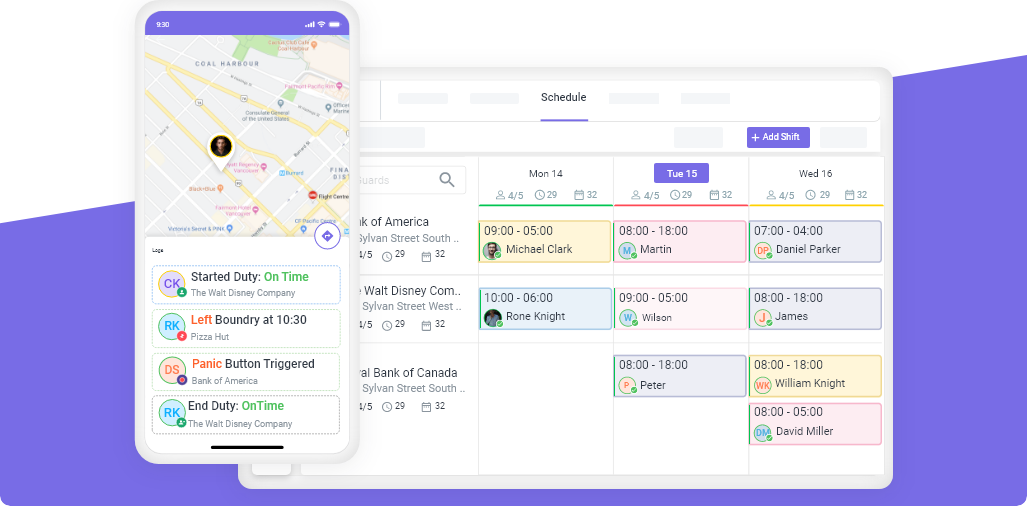How to Use Workforce Management to Boost Customer Satisfaction
Fri, Jul 26, 2024
Read in 7 minutes
Giving excellent customer service and increasing customer satisfaction is a must. And that can be made possible by using effective workforce management strategies. Learn what they are and how to use them to boost productivity and increase sales.

Effective workforce management (WFM) is crucial for businesses aiming to enhance customer satisfaction. By ensuring that employees are in the right place at the right time and performing tasks efficiently, companies can significantly improve their service quality. Leading to happier customers. A client’s satisfaction always plays a very large role in the success of any business. If you want to grow, you need to provide good customer service.
Now when you are just building your company, it might be very easy to manage the operations without any help. But what about when the business grows? You will need to have new staff, bigger budgets, and tight schedules. Then you will need to have some help. And that comes in the form of workforce management. This blog explores what workforce management is, its connection to customer satisfaction, strategies for effective implementation, and the benefits it offers.
What is Workforce Management?
Workforce management is a set of processes and tools used by organizations to optimize employee productivity. It includes forecasting, scheduling, real-time monitoring, and performance management. The primary goal is to ensure that the right number of staff with the right skills are available to meet business demands at any given time.
Key Components of Workforce Management:
- Forecasting: This involves predicting future staffing needs based on historical data and business trends. Accurate forecasting helps businesses prepare for peak times and avoid under- or overstaffing.
- Scheduling: Assigning employees to shifts and tasks to ensure adequate coverage during busy periods. Good scheduling takes into account employee skills, preferences, and availability.
- Real-Time Monitoring: Tracking employee activities and customer demand to make immediate adjustments. This ensures that any sudden changes, such as increased customer flow or unexpected staff absences, are managed effectively. This way your customer is also not disturbed and you have enough coverage on shift too.
- Performance Management: Evaluating employee performance to identify areas for improvement and provide constructive feedback. This helps in enhancing overall productivity and service quality.
Effective WFM systems use technology to automate these processes. Making them more efficient and accurate. Tools such as workforce management software, AI, and data analytics are commonly used to streamline WFM tasks and enhance decision-making. And with this, you can increase a client’s satisfaction easily.
The Connection Between Workforce Management and Customer Satisfaction
Workforce management plays a pivotal role in shaping the customer experience. Here’s how:
1. Improved Service Delivery:
Well-managed scheduling ensures that there are enough employees to handle customer needs. Reducing wait times and improving service quality. Real-time monitoring helps managers make on-the-go adjustments. Ensuring that service levels remain high even during unexpected demand spikes. For instance, a restaurant that accurately predicts busy hours can schedule extra staff during those times, ensuring customers receive prompt service.
2. Enhanced Employee Morale:
Effective WFM not only benefits customers but also employees. When employees are scheduled appropriately and their workloads are balanced, they are less likely to experience burnout. Happy employees are more engaged and motivated, leading to better interactions with customers. For example, in a retail setting, employees who are not overworked can give more attention and better service to each customer. An employee will only take care of client’s satisfaction if they are satisfied themselves.
Pro tip- Dealing with low job satisfaction? Read this blog to know more.
3. Consistency Across Channels:
By aligning workforce capabilities with customer demand, businesses can deliver a consistent customer experience across various channels. Whether customers are engaging through in-person interactions, over the phone, or online. A well-managed workforce ensures that service quality is maintained. This is particularly important for businesses that operate in multiple locations or offer multiple services. Customer experience management is very important in that matter. It gives a proper view of what is happening with the customers.
Implementing Effective Workforce Management Strategies
To enjoy the benefits of workforce management, businesses must implement effective strategies. Here are some key approaches:
1. Utilize Workforce Management Software:
Invest in robust WFM software that can automate forecasting, scheduling, and monitoring. These tools provide real-time data and analytics, helping managers make informed decisions quickly. For instance, a call center can use WFM software to predict call volumes and schedule agents accordingly, ensuring that customer calls are answered promptly.
2. Leverage Data Analytics:
Use data analytics to gain insights into customer demand patterns and employee performance. This information can guide scheduling decisions, ensuring that staffing levels align with peak demand times. For example, a retail store can analyze sales data to determine the busiest shopping hours and schedule more staff during those times.
3. Promote Continuous Improvement and Learning:
Encourage a culture of continuous improvement by providing ongoing training and development opportunities for employees. Regular feedback and performance evaluations help employees understand their strengths and areas for growth. Leading to better performance and customer interactions. In a healthcare setting, ongoing training can ensure that staff are up-to-date with the latest medical protocols, improving patient care.
4. Align Workforce with Organizational Goals:
Ensure that all employees understand the business’s goals and how their roles contribute to achieving them. This alignment creates a sense of purpose and motivates employees to perform at their best. For instance, in a sales organization, aligning individual sales targets with the company’s revenue goals can drive better performance and customer satisfaction.
Benefits of Workforce Management for Customer Satisfaction
Implementing effective workforce management strategies offers many benefits. Both for businesses and their customers:
1. Enhanced Service Delivery:
Optimized staffing ensures that customer needs are met promptly. Leading to faster service and higher satisfaction levels. For example, a hotel with well-managed staffing can provide quick check-in and check-out services, enhancing the guest experience. Customer feedback can be collected through customer experience management software. This way you know where the gap is.
2. Increased Employee Productivity and Morale:
When employees are scheduled effectively and their workloads are balanced, they are more productive and satisfied with their jobs. This positive work environment translates into better customer service. In a manufacturing setting, balanced workloads can reduce errors and improve product quality.
3. Consistent Customer Experience:
With proper WFM, businesses can provide a consistent level of service across all customer touchpoints. This consistency builds trust and loyalty among customers. For instance, a bank that manages its workforce well can ensure that customers receive the same level of service whether they visit a branch, use an ATM, or call customer service.
4. Cost Savings:
Efficient workforce management reduces the need for overtime and minimizes labor costs. By aligning staffing levels with actual demand, businesses can avoid overstaffing or understaffing, optimizing their labor budget. For example, a retail chain that uses WFM software can ensure that staff hours are aligned with sales patterns, reducing unnecessary labor costs.
5. Competitive Advantage:
A well-managed workforce enables businesses to respond quickly to market changes and customer demands. This agility provides a competitive edge in delivering superior customer service. For example, a logistics company with effective WFM can quickly adapt to changes in delivery schedules. Ensuring timely deliveries and satisfied customers.
Conclusion
In conclusion, workforce management is essential for businesses aiming to boost customer satisfaction. By effectively forecasting, scheduling, and monitoring employees, companies can ensure high service quality, improve employee morale, and achieve cost savings. Implementing these strategies not only enhances the customer experience but also provides a significant competitive advantage.
Effective workforce management is a critical aspect of running a successful business. By ensuring that employees are optimally utilized and aligned with business needs, companies can enhance their service delivery, improve employee satisfaction, and achieve significant cost savings.
Whether you are a small business owner or a manager in a large corporation, adopting effective workforce management practices can help you create a more efficient, productive, and customer-centric organization.
Get a Free Trial
Sign up For Newsletter
Latest Blog Posts
Get Started
Start being productive & grow your business
with Novagems




